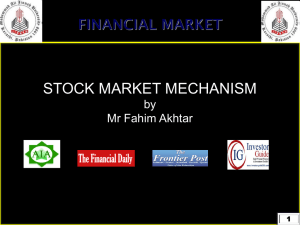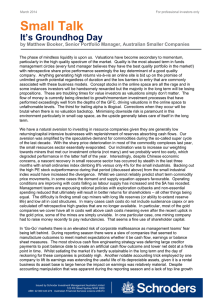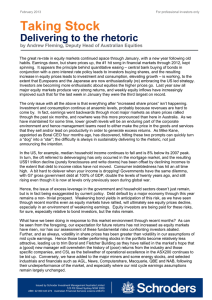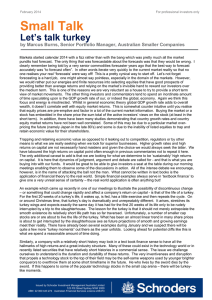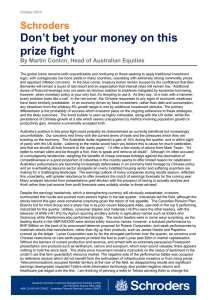Sucking the marrow out of life Small Talk Smaller Companies
advertisement
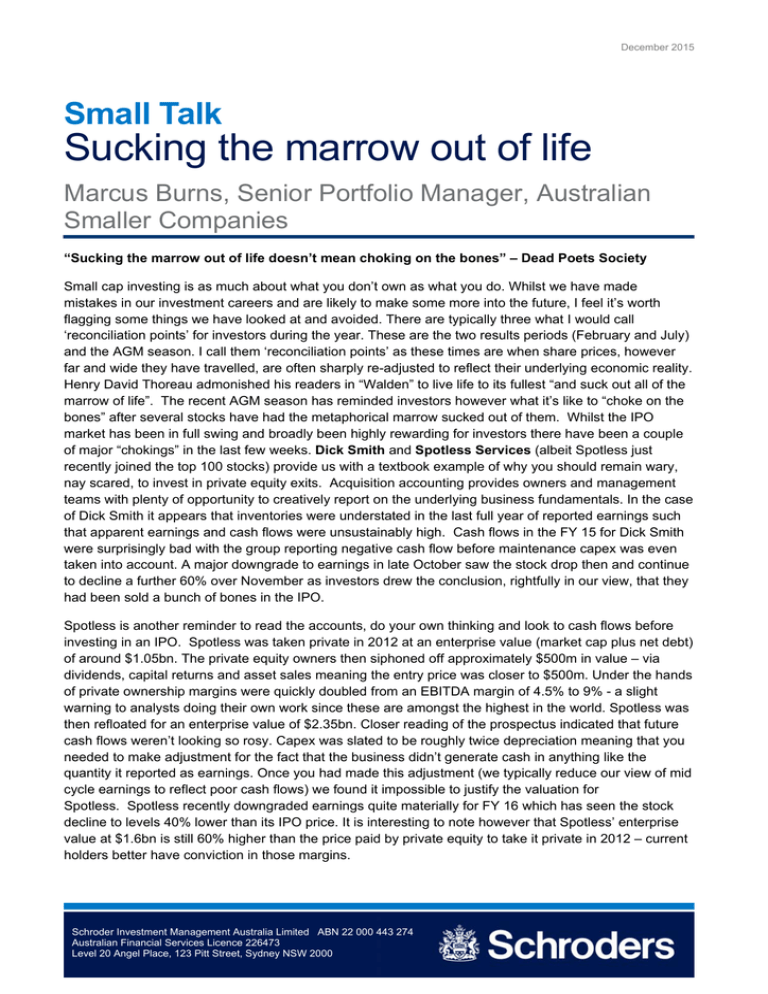
December 2015 Small Talk Sucking the marrow out of life Marcus Burns, Senior Portfolio Manager, Australian Smaller Companies “Sucking the marrow out of life doesn’t mean choking on the bones” – Dead Poets Society Small cap investing is as much about what you don’t own as what you do. Whilst we have made mistakes in our investment careers and are likely to make some more into the future, I feel it’s worth flagging some things we have looked at and avoided. There are typically three what I would call ‘reconciliation points’ for investors during the year. These are the two results periods (February and July) and the AGM season. I call them ‘reconciliation points’ as these times are when share prices, however far and wide they have travelled, are often sharply re-adjusted to reflect their underlying economic reality. Henry David Thoreau admonished his readers in “Walden” to live life to its fullest “and suck out all of the marrow of life”. The recent AGM season has reminded investors however what it’s like to “choke on the bones” after several stocks have had the metaphorical marrow sucked out of them. Whilst the IPO market has been in full swing and broadly been highly rewarding for investors there have been a couple of major “chokings” in the last few weeks. Dick Smith and Spotless Services (albeit Spotless just recently joined the top 100 stocks) provide us with a textbook example of why you should remain wary, nay scared, to invest in private equity exits. Acquisition accounting provides owners and management teams with plenty of opportunity to creatively report on the underlying business fundamentals. In the case of Dick Smith it appears that inventories were understated in the last full year of reported earnings such that apparent earnings and cash flows were unsustainably high. Cash flows in the FY 15 for Dick Smith were surprisingly bad with the group reporting negative cash flow before maintenance capex was even taken into account. A major downgrade to earnings in late October saw the stock drop then and continue to decline a further 60% over November as investors drew the conclusion, rightfully in our view, that they had been sold a bunch of bones in the IPO. Spotless is another reminder to read the accounts, do your own thinking and look to cash flows before investing in an IPO. Spotless was taken private in 2012 at an enterprise value (market cap plus net debt) of around $1.05bn. The private equity owners then siphoned off approximately $500m in value – via dividends, capital returns and asset sales meaning the entry price was closer to $500m. Under the hands of private ownership margins were quickly doubled from an EBITDA margin of 4.5% to 9% - a slight warning to analysts doing their own work since these are amongst the highest in the world. Spotless was then refloated for an enterprise value of $2.35bn. Closer reading of the prospectus indicated that future cash flows weren’t looking so rosy. Capex was slated to be roughly twice depreciation meaning that you needed to make adjustment for the fact that the business didn’t generate cash in anything like the quantity it reported as earnings. Once you had made this adjustment (we typically reduce our view of mid cycle earnings to reflect poor cash flows) we found it impossible to justify the valuation for Spotless. Spotless recently downgraded earnings quite materially for FY 16 which has seen the stock decline to levels 40% lower than its IPO price. It is interesting to note however that Spotless’ enterprise value at $1.6bn is still 60% higher than the price paid by private equity to take it private in 2012 – current holders better have conviction in those margins. Schroder Investment Management Australia Limited ABN 22 000 443 274 Australian Financial Services Licence 226473 Level 20 Angel Place, 123 Pitt Street, Sydney NSW 2000 Small Talk: December 2015 Whilst not seeking to gain schadenfreude from other people’s misery, Slater & Gordon continued to air its woes in November. The stock declined a further 66% after two negative announcements. The first was an AGM update in which they maintained their EBITDAW guidance (can anyone else dream up a new form of earnings to report with even more letters please?) but cautioned that the first half would see negative cash flow to the tune of $30-40m. This was in spite of the company proudly reporting its seemingly relatively robust cash flow conversion every year for the past 4-5 years which we have long argued has been overstated due to the immediate tax deductibility of acquired WIP (Work In Progress – that is cases which the firm has commenced but not yet settled). The second and potentially more serious announcement was that the UK government had decided to cap the amount to be paid by insurers in relatively minor road accidents. The UK has seen a substantial increase in legal costs relating to small traffic accidents in the face of a decline in number of motor accidents. This has seen the cost of motor insurance rise and little in the way of net benefit to society. Given that approximately half of Slater & Gordon’s revenues are derived from UK motor accidents, it means revenues in future years could be severely impacted. Lastly, the company retains about $600m of net debt after they bought Quindell in the UK back in March of this year. These stocks have been highlighted chiefly to make the point that stock investing, whilst stimulating and enjoyable, can also have its pitfalls. Our approach is to try to reduce (to zero if possible) the number of investments that have these type of characteristics. Chief amongst those traits are geared balance sheets combined with low to zero cashflow generation. Several of the stocks mentioned earlier are now unable to turn to their shareholders to raise the cash to be able to meaningfully reduce their debt burden as their market caps are materially lower than their net debt balances. I’ve also sought to highlight how these stocks are treated in our valuation process. We typically adjust down our view of their mid cycle earnings to account for consistently poor cash flow generation and would often ascribe a higher risk score to such a business. Most of these businesses have had risk scores in the upper quartile of our investment universe based on either their operating and/or financial leverage. This process of risk assessment necessarily keeps stocks like these either out of portfolios or their relative weightings low and only if there were substantial upside to their valuations. Outlook With the third ‘reconciliation point’ now over for the year, stocks are likely to experience some detachment from reality until we see first half results in Q1 of 2016. We see our job as one of constantly sifting through our universe looking for ideas to upgrade our holdings and retire realised or tired holdings from the portfolio. We are in the business of owning businesses not renting stocks by which I mean we like to understand what we are buying on our clients’ behalf. We like to find those businesses whose managers act at least in part like owners/investors and eschew those who merely view the stock market as a liquidity pool from which they can suck the unsuspecting marrow from investors’ bones. Important Information: Opinions, estimates and projections in this article constitute the current judgement of the author as of the date of this article. They do not necessarily reflect the opinions of Schroder Investment Management Australia Limited, ABN 22 000 443 274, AFS Licence 226473 ("Schroders") or any member of the Schroders Group and are subject to change without notice. In preparing this document, we have relied upon and assumed, without independent verification, the accuracy and completeness of all information available from public sources or which was otherwise reviewed by us. Schroders does not give any warranty as to the accuracy, reliability or completeness of information which is contained in this article. Except insofar as liability under any statute cannot be excluded, Schroders and its directors, employees, consultants or any company in the Schroders Group do not accept any liability (whether arising in contract, in tort or negligence or otherwise) for any error or omission in this article or for any resulting loss or damage (whether direct, indirect, consequential or otherwise) suffered by the recipient of this article or any other person. This document does not contain, and should not be relied on as containing any investment, accounting, legal or tax advice. Schroders may record and monitor telephone calls for security, training and compliance purposes. Schroder Investment Management Australia Limited 2
